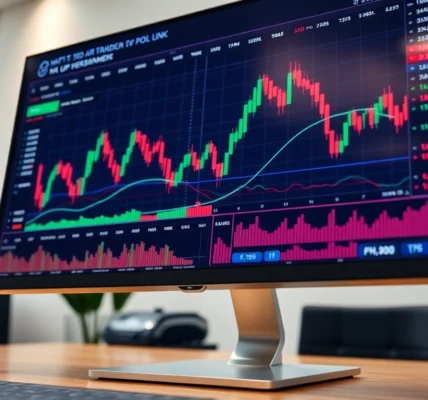Introduction to Trading View and Its Key Features
In today’s fast-paced financial markets, having access to real-time data, advanced analytical tools, and a vibrant community is essential for traders and investors alike. One platform that has gained widespread popularity for fulfilling these needs is trading view. Recognized for its robust charting capabilities, social engagement, and comprehensive market coverage, Trading View offers a versatile environment tailored to both beginners and seasoned traders. Whether you’re tracking cryptocurrencies, stocks, forex, or commodities, the platform’s seamless integration of technical analysis, market insights, and social features makes it a top choice in the crowded trading software landscape.
Trading View’s key features include intuitive interactive charts, customizable indicators, real-time alerts, social networking tools for idea sharing, and API integrations. Its user-friendly interface combined with powerful analytical tools allows traders to make informed decisions swiftly. As the platform continuously evolves, it incorporates community-driven strategies, custom script development, and multi-market analysis, ensuring it remains at the forefront of financial technology.
Understanding Trading View’s Platform Capabilities
Charting and Technical Analysis
At its core, Trading View’s platform excels in charting and technical analysis. Users can access a wide array of chart types—including line, bar, candlestick, and renko charts—each customizable for specific analysis needs. The platform supports numerous technical indicators like moving averages, RSI, MACD, Bollinger Bands, and more, enabling traders to identify trends, reversals, and potential entry/exit points with precision.
Beyond standard indicators, Trading View allows for the creation of custom scripts using its proprietary Pine Script language. This feature empowers traders to develop personalized strategies, backtest historical data, and automate signals, elevating the analytical depth available on the platform.
Market Data and Coverage
Trading View aggregates data from major global exchanges, covering a broad spectrum of markets such as equities, cryptocurrencies, forex, commodities, and indices. This extensive market coverage enables traders to monitor multiple assets within a single interface, facilitating cross-market analysis and diversification strategies.
Real-time data feeds and delayed updates are accessible based on user subscriptions, ensuring traders have the most current market insights. The platform also offers economic calendars, news feeds, and fundamental analysis tools to complement technical insights.
Community and Social Networking
One unique aspect of Trading View is its built-in social network where traders share ideas, strategies, and insights. The community features include idea publishing, comment sections, chat rooms, and follow options. This fosters collaborative learning and helps traders stay informed about market sentiment, trending strategies, and real-world experiences.
Getting Started with Trading View
Creating Your Account and Customizing Your Dashboard
Initiating your journey with Trading View begins with creating an account, which is straightforward and free. Once registered, users can personalize their dashboards by adding favorite assets, customizing chart layouts, and arranging tools to match their trading style.
Advanced users can set up multiple workspace layouts—for example, different configurations for forex, stocks, or cryptocurrencies—allowing quick switching between analysis modes without losing insights.
Using Basic Tools: Charts, Indicators, and Watchlists
In its simplest form, Trading View allows users to generate comprehensive charts with drag-and-drop indicators and drawn tools. Watchlists enable tracking of selected assets, and with one click, traders can access historical data, current prices, and relevant news. The platform’s intuitive toolbar simplifies the addition of technical indicators and drawing tools for pattern analysis.
Setting Up Alerts for Market Movements
Market alerts are crucial for timely decision-making. Trading View’s alert system can notify traders via pop-ups, emails, or SMS when specific conditions are met—for example, price crossing a support/resistance level or an indicator signaling overbought/oversold conditions. Setting up alerts is straightforward: right-click on a chart or use the alert menu to define custom conditions, and let the platform do the rest.
Advanced Trading View Techniques
Implementing Custom Indicators and Scripts
Power users leverage Pine Script to enhance analysis capabilities. Custom scripts can be shared within the community or tailored for personal strategies. Backtesting tools evaluate the efficacy of these scripts over historical data, enabling traders to optimize parameters before risking real capital.
For example, traders might develop a custom oscillator that combines multiple indicators, or automate complex entry and exit signals—maximizing efficiency and reducing emotional bias.
Integrating Trading View with Other Trading Platforms
Trading View supports integration with several brokerage accounts, allowing traders to execute trades directly from the platform. This integration streamlines workflow, reduces latency, and provides a unified environment for analysis and execution. Supported brokers include Forex, stock, and crypto trading firms, making it versatile across asset classes.
Leveraging Community Ideas and Social Features
Community ideas are a rich resource for learning and validation. Users can browse, comment, and follow traders whose analysis aligns with their investment style. By engaging with community insights, traders gain diverse perspectives, learn innovative strategies, and stay updated on market sentiment trends.
Optimizing Trading View for Better Trading Decisions
Analyzing Multiple Markets Simultaneously
The platform’s multi-chart layout enables simultaneous monitoring of various assets. Traders can compare correlated markets or diversify analysis, facilitating holistic decision-making. Custom hotkeys and templates further expedite this process during fast-moving markets.
Using Backtesting and Strategy Testing Tools
Backtesting allows traders to evaluate how their strategies would have performed historically, lending confidence before live deployment. Trading View’s strategy tester provides detailed metrics such as profit factor, drawdown, and win rate, ensuring traders understand risk-reward profiles thoroughly.
Applying Data-Driven Insights for Entry and Exit Points
Combining multiple indicators, pattern recognition, and community ideas creates a comprehensive decision framework. Data-driven trading minimizes emotion-driven decisions, enhances probability of success, and improves overall trading psychology. Regularly reviewing performance metrics and adjusting strategies based on insights ensures continuous growth.
Performance Metrics and Best Practices
Monitoring Your Trading Performance on Trading View
Trading View’s portfolio and performance tracking tools enable traders to monitor their ongoing strategies. Detailed analytics such as profit/loss, win/loss ratios, and drawdowns help identify strengths and weaknesses.
Maintaining a Trading Journal with Trading View Tools
Documenting trades, rationales, and outcomes is vital for continuous improvement. The platform allows for notes and annotations directly on charts, facilitating a structured trading journal. Regular review of journal entries provides insights into recurring mistakes and successful patterns.
Continuous Learning and Community Engagement
Active participation in forums, idea sharing, and strategy development keeps traders at the cutting edge. Attending webinars, following market analysts, and experimenting with new tools foster growth and adaptability in evolving markets.




